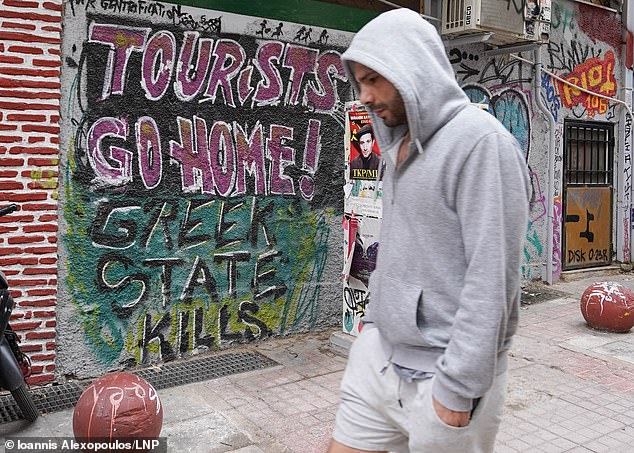A world-famous rock, which has preserved dinosaur footprints, has been defaced with graffiti reading “tourists go home.”
The anti-tourism slogan was scrawled next to prehistoric footprints more than 220 million years old, sparking outrage in the country.
Paralympic athlete and climber Moreno Pesce made the shocking discovery while training in the Dolomites in northern Italy, it was reported. ANSA.
In a video posted online, the athlete can be seen shaking his head as he shows off his findings.
Pesce said: “It was not a good awakening for the Tre Cime.”
Paralympic athlete and climber Moreno Pesce made the shocking discovery while training in the Dolomites in northern Italy.

The anti-tourism slogan was scrawled next to prehistoric footprints more than 220 million years old.

The Dolomites are a tourist hotspot in Italy with more than four million visitors each year.
The vandalism took place between the Auronzo and Lavaredo mountains, which are home to some of the most popular hiking trails in Italy.
The dinosaur footprints were discovered in 1992 and are believed to have been shaped during the Triassic period, between 250 and 200 million years ago.
This discovery led to similar finds in the Dolomites and experts believe the area was the site of a real dinosaur trail during prehistoric times.
During the summer, around four million tourists venture to this picturesque mountain range each year.
It comes after a wave of anti-tourism protests across Europe this summer, which have become especially frequent in British tourist hotspots across Spain.
Earlier this month in Ibiza, 1,000 protesters took to the streets calling for more restrictions on tourism on the island, as locals argued that Ibiza’s transformation into a “luxury destination” was causing serious socio-economic problems for residents.
The march was organized by the major anti-tourism platform Caviem el Rumb, which has been holding demonstrations throughout the summer in the Spanish tourist hotspot.
Meanwhile, on the neighboring island of Mallorca, anti-tourism protests have rocked the Balearic island this summer.

Anti-tourist protests escalate in sinister turn as ‘kill a tourist’ graffiti appears on a wall in Mallorca

Protesters threw water guns at tourists eating at popular Barcelona spots in July.

Earlier this month in Ibiza, 1,000 protesters took to the streets calling for more restrictions on tourism on the island, as locals argued that Ibiza’s transformation into a “luxury destination” was causing serious socio-economic problems for residents.
The island welcomed a record 17.8 million tourists last year, but now locals are demanding a limit on the number of foreign visitors allowed to visit Mallorca.
In July, up to 50,000 locals took to the streets of Palma, the Majorcan capital.
Anti-tourism protests took a sinister turn when graffiti reading “kill a tourist” was seen in the city of Manacor.
The center-right Popular Party condemned the act of vandalism and urged the Manacor City Council to “collaborate in its immediate cleanup.”
The PP spokesperson, María Antonia Sansó, stated that the graffiti does not represent the general sentiment of the residents of Manacor and described the act as “totally unjustified.”
Also in July, Barcelona residents took to the streets demanding a reduction for the millions of tourists who come to the city each year.
Protesters carried signs reading “Barcelona is not for sale” and “Tourists go home”, before some armed with water guns began spraying restaurateurs in popular tourist spots.
Chants of “Tourists out of our neighborhood” could be heard as some stopped outside hotel entrances.
The rising cost of housing in Barcelona, up 68 percent in the last decade, is one of the movement’s main problems, along with the effects of tourism on local commerce and working conditions in the city of 1.6 million inhabitants.
Tenerife witnessed one of the largest organized anti-tourism demonstrations, with more than 200,000 protesters taking to the streets on April 20.
Elsewhere in Europe, anti-tourism graffiti has appeared in Naples and the Greek capital Athens.

Thousands of people demonstrate against tourism policies on the island of Tenerife, Canary Islands, Spain, on April 20, 2024.

Pictured: A ticket office where tourists can buy a day pass to Venice, seen on April 25.

A chilling graffiti in Athens reads: ‘Tourists are going home! The Greek state kills
Governments have also begun to use the legislation in an attempt to curb tourist numbers. Since April 25 this year, tourists arriving in Venice must pay a daily fee of €5 (£4.30) to enter at peak times under a pilot scheme.
Officials hope the fee will deter visitors from arriving on peak days and make the city more livable for its dwindling residents.
Last year, Amsterdam made headlines when Amsterdam officials urged British tourists to “stay away” from the city.
The initiative was launched as part of an attempt to renew the image of the Dutch capital, which in recent years has become famous for its liberal drug policy and its famous red light district.
The Amsterdam campaign, called “Stay Away”, involved people seeing warnings when they searched online for terms such as “Amsterdam stag party” or “pub crawl”.
“The campaign will start in Great Britain and will be aimed at men between the ages of 18 and 35,” Amsterdam city council said in a statement at the time.


